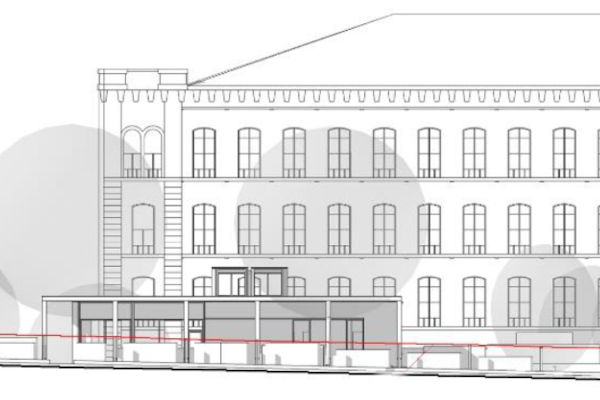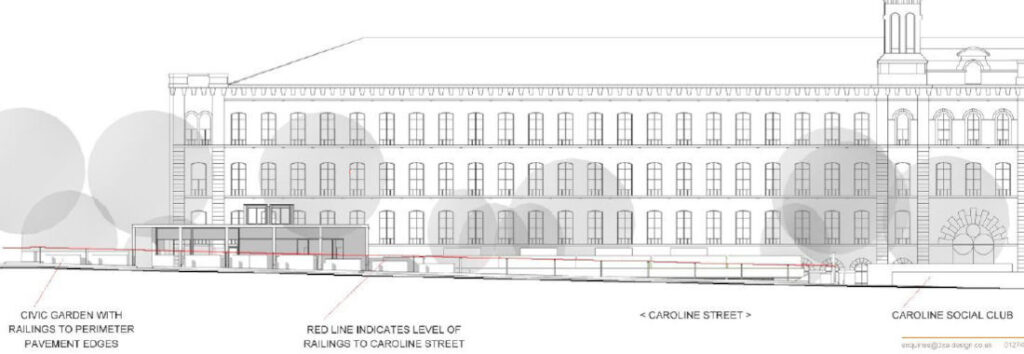Community, Arts, Heritage and Future Technology Building: Summary of key facts, July 2024
For anyone concerned about the proposed new Community, Arts, Heritage and Future Technology Centre building for Saltaire, planned for the corner site, Victoria Road and Caroline Street:
We have summarised below the key facts about the process of involving UNESCO and its advisors, and also our response to the concerns raised in Feb 2023 by UNESCO’s advisory body ICOMOS.
ICOMOS received a full and detailed response to their concerns in 2023 and have not raised any further concerns.
Adherence to World Heritage Committee Guidelines and UNESCO Guidance
Paragraph 172 of the UNESCO Operational Guidelines requires State Parties to inform the World Heritage Committee of developments that may affect a property’s outstanding universal value. Historic England is the historic environment statutory advisor, and they supported the Community, Arts, Heritage and Future Technology (CAHFT) scheme with sight of all the relevant planning documentation.
Historic England is the body that advises at local and national government level, with national government being the channel through which any correspondence with UNESCO and their advisor – ICOMOS International – occurs. The UK Ambassador to UNESCO forwarded the notification to UNESCO from the state party (i.e. Department for Culture, Media and Sport) with input from Historic England.
At the pre-planning stage (February 2023) ICOMOS responded with a 3-page analytical review, covered by the letter to them from the UK ambassador and one page stating the World Heritage Criterion met by the Saltaire site. See below for responses to the key concerns raised by ICOMOS.
UNESCO did not respond to the paragraph 172 notification and has not done so throughout the preparatory or formal planning process. Please Note: There is NO evidence that the building threatens the World Heritage Status of Saltaire. UNESCO has never said that, and neither has ICOMOS.
New UNESCO Guidance for Heritage Impact Assessments (HIA) in a World Heritage Context (issued in August 2022) was also adhered to. Shipley College, advised by Historic England, secured an Independent body, Humble Heritage, to carry out a full HIA for the proposed CAHFT building. The assessment was completed in July 2023. The full 44 page assessment is available for download here.
The HIA concluded:
This Heritage Impact Assessment report makes the recommendation that [planning] approval is given, subject to the mitigation measures noted. The majority of impacts of the proposed action on the attributes of the World Heritage Site have been evaluated to be major positive.
Where negative impacts will occur, unavoidably, in the construction phase these impacts will be minor negative and temporary and with mitigation will be reduced to an acceptable1 level. (these were the only negative impacts identified).
At the formal planning application stage Shipley College and the Saltaire World Heritage Education Association (the Saltaire Collection’s parent charity) were aware that the Council’s planning officer tried to make direct contact to satisfy himself that no response to the notification of the formal planning process in August 2023 (by Historic England). No response was forthcoming.
All procedures undertaken by Shipley College and Bradford Metropolitan District Council Planning Authority complied with current UNESCO guidance. UNESCO’s continued oversight is welcomed.
Response to ICOMOS concerns
1. ICOMOS stated that the original use of the proposed site for CAHFT (was) as green space, citing the later erosion of other green spaces within the property as a reason to ensure that what remains is retained. It considers this is essential as the green spaces between the buildings that formed part of the original plan contribute to the idea of a garden city as expressed under the justification for criterion (ii) ‘exert influence on the garden city movement…’
Response: There is little historical evidence to support the site as being originally intended for green space by Salt. Jack. Reynolds’ key work on the history of Saltaire (The Great Paternalist: Titus Salt and the Growth of Nineteenth Century Bradford) reports that this space was intended for a hotel. Most historians agree that the plan for Saltaire was for urban design within a rural setting. The allotments established in 1868 near Saltaire Mill, as with the later plan for Saltaire was an iterative development. Roberts (Saltaire) Park offers vast green space.
Notably, Titus Salt commissioned an imposing three-story Congregational Sunday school for 700 scholars as the last building in his lifetime. It was built on the site for the proposed CAHFT building. The school opened in 1876 shortly before Salt died. It was only demolished in the 1970s.
UNESCO state Saltaire was to exert influence on the ‘garden city movement’ of the early 20th century but there is no known evidence to support that view. This view is understandable, however.
2. ICOMOS stated that ‘The current arrangement on the site in the area in front of the Mill (car park, temporary buildings) is considered less than ideal but not irreversible at the current time. Whereas if a major new building was constructed on the site it is considered that this would become almost impossible. Ideally, ICOMOS would prefer to see the original use as allotment gardens reinstated’.
Response: Regarding the issue of ‘original use’, please see the previous response regarding ‘green space’.
The site is not ‘in front of the mill’ – there is a railway line and a significant area for the original allotments between the site and the mill. The proposed building does not mask the side view of the mill, see the image below. In addition, the proposed civic garden facing Victoria Road (size of that outside Victoria Hall) offers well- planned green space.
3. ICOMOS points specifically to the exploration of potential to house the centre within Salt’s Mill itself, a solution which it sees as beneficial to the long-term sustainable maintenance of the property. It cites the need to find a location that does not impact adversely on the overall plan of the property and its visual and functional interlinkages.
Response: Salts Mill is a commercial operation with many visitors and the Heritage Impact Assessment considered this option but rejected it as not suitable for the College students.
For Saltaire Collection, occupying a College building brings security of tenure, reduced financial outlay and significant financial, technical and HR professional support.

